Jeep Wrangler Front Brake
Pads Replacement Guide
How to change the front brake pads on a
4th generation JL 2018 to 2023 Jeep Wrangler SUV.
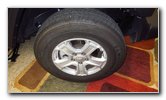 2020 Wrangler Wheel |
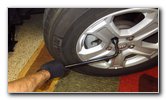 Slightly Loosen Lug Nuts |
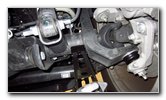 Front Jack Point |
|
This automotive maintenance tutorial was specifically written to assist owners of the "JL" fourth generation (2017, 2018, 2019, 2020, 2021, 2022 & 2023) Jeep Wrangler SUV in changing the front disc brake pads including instructions for replacing the brake rotors if necessary. Owners of other Jeep, Dodge and RAM vehicles such as the Grand Cherokee, Compass, Renegade, Gladiator, Cherokee, Grand Wagoneer, Wagoneer, Charger, Challenger, Durango, RAM 1500, Promaster, 2500 and 3500 may also find these DIY instructions to be helpful. A few compatible replacement front brake pads with their part numbers are as follows: Power Stop 17-1589, Raybestos EHT1589H, ACDelco 14D1589CHF1, Centric Parts 102.12730 and Akebono ACT1589. The tools and other items needed to complete this procedure include a floor jack, two jack stands, a lug nut wrench, a 13mm socket with a 3/8" drive ratchet, an "F" clamp and a tube of brake parts lubricant grease. The first few steps are to park the SUV on a level surface, turn off the ignition, shift the gear selector into "P" (Park) and engage the emergency / parking brake. It would also be a good idea to place wheel chocks on both sides of the rear tires to help prevent the vehicle from moving unexpectedly. Slightly loosen the five lug nuts in the counterclockwise direction with the tire iron. |
||
|
|
||
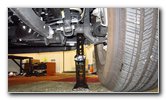 Raise Front of Car |
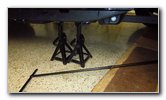 Support With Jack Stands |
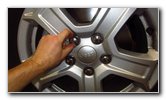 Spin Off Five Lug Nuts |
|
Carefully raise the front of the vehicle with the floor jack placed under the jack point as shown in the picture or please see your owner's manual. Securely support the car with at least two jack stands. Spin off the five lug nuts in the counterclockwise direction and set them aside in a safe place. |
||
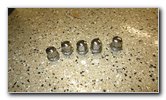 Five Lug Nuts Removed |
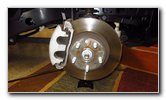 Caliper, Bracket, Rotor |
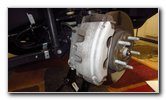 Two Caliper Bolts |
| Remove the front
wheel and tire to reveal the caliper, bracket, rotor and suspension. The front brake caliper is held in place to the bracket by two bolts located on the back side of the caliper. |
||
 Loosen Bolt Clockwise |
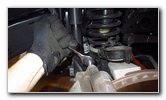 Loosen Top Caliper Bolt |
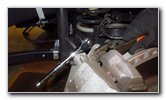 Pliers - Hold Slide Pin |
| Loosen the bottom
caliper bolt by turning it in the clockwise direction (as seen from the
outside of the vehicle) with a 13mm socket and a 3/8" drive ratchet. If the caliper slide pin turns as you are attempting to loosen the caliper bolt, hold it in place with pliers. Loosen the top caliper bolt by turning it in the clockwise direction (when viewed from the outside of the car) with a 13mm socket and a 3/8" drive ratchet. Note - If you were to slide under the engine bay and look at the back side of the caliper, you would loosen the caliper bolts in the "normal" counterclockwise direction. Since we are viewing the caliper from the outside of the vehicle, the orientation is reversed and the bolts are loosened by turning the ratchet in the clockwise direction. |
||
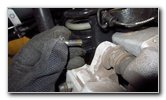 Spin Out Upper Bolt |
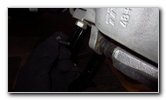 Spin Out Lower Bolt |
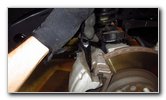 Loosen Brake Caliper |
| Spin out the two
caliper bolts and set them aside in a safe place. If the caliper is stuck to the old pads or the bracket, use a large flat head screwdriver or the flat end of the lug nut wrench to pry it out. |
||
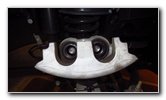 Rest Caliper On Rotor |
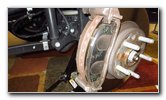 Remove Old Pads |
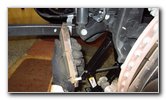 Wear Bar - Bottom Inner |
| Lift the caliper
out of the bracket and off the old pads. Rest the caliper on the suspension. Try to avoid bending, kinking, twisting or pulling the rubber brake fluid hose. Pull the old brake pads out of the bracket. Make a mental note of where the wear indicator bar or "squeal bar" is situated on the old pads. On this 2020 Wrangler, the wear indicator bar was located at the bottom of the inner brake pad. |
||
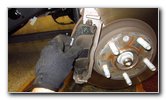 Remove Outer Pad |
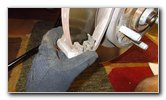 Replace Abutment Clips |
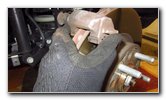 Replace Abutment Clips |
| If your new set of
front brake pads includes a bag of new brake hardware, remove the old pad
abutment or "anti-rattle" clips out of the top and bottom of the bracket. Clean off the rotor, bracket and caliper with brake parts cleaner spray. Allow the parts to dry. Apply a thin layer of brake parts lubricant grease to the top and bottom of the new pad abutment clips. Push the new pad abutment clips into the top and bottom of the bracket. Make sure the clips are fully seated in place. |
||
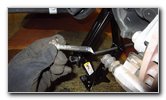 Lubricate Slide Pins |
 DO NOT MIX UP PINS |
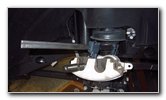 Attach "F" Clamp |
| In order for the
caliper to operate smoothly, the two caliper slide pins need to be well
lubricated. Remove one pin at a time, apply a thin layer of brake caliper grease to the smooth part of the pin and push it back into place. Do NOT mix up the top and bottom caliper slide pins as on most vehicles they are slightly different with a trailing and leading pin. The leading pin will usually be equipped with a rubber bushing (or sleeve) that dampens vibration. In order for the caliper to fit over the thicker new brake pads, the two caliper pistons need to be compressed back into place. Attach the "F" clamp to the caliper and use the back of an old brake pad to evenly distribute the pressure across the two pistons. |
||
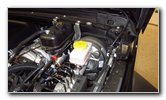 Brake Fluid Reservoir |
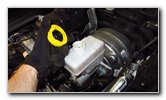 Twist Off Yellow Cap |
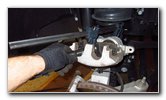 Slowly Compress Pistons |
| Move to the rear
right (driver) side of the engine bay. Twist off the yellow brake fluid reservoir cap in the counterclockwise direction. Removing the reservoir cap will allow the brake fluid to more easily travel back through the lines when you compress the pistons. Slowly turn the "F" clamp handle in the clockwise direction to compress back the caliper pistons. Repeatedly check the fluid level in the reservoir to make sure it doesn't overflow. Clean up any spilled brake fluid immediately since it can easily damage painted surfaces. Continue retracting the caliper pistons until they are just about flush with the rubber dust boots that surround them. Try to avoid pinching or otherwise damaging the rubber dust boots. Rotor Replacement Instructions If you've been feeling shuddering, shaking or vibrations in the front end during braking, you probably need to replace the front rotors. To replace the rotors, remove the two 21mm bolts on the back side of the caliper bracket and detach the bracket from the steering knuckle. Remove the rotor set screw by loosening it in the counterclockwise direction with a Torx T30 screwdriver. Slide the old rotor off the hub. If the rotor won't come off, hit it a few times with a rubber mallet to loosen any rust. Clean off the hub and new rotor with brake parts cleaner spray. Slide the new rotor into place, replace the bracket and tighten the two 21mm bolts to 148 lb-ft (or 200 N*m) with a torque wrench. |
||
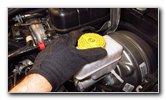 Replace Brake Fluid Cap |
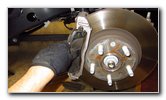 Install New Outer Pad |
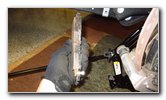 Wear Bar - Bottom Inner |
| Replace the brake
fluid reservoir cap as soon as possible. Brake fluid is hygroscopic (easily
absorbs moisture from the air) so the cap should be left off any longer than
necessary. Install the new inner and outer brake pads into the bracket. I recommend buying the Power Stop 17-1589 front brake pads since they have excellent reviews from other Wrangler owners. Be sure to orientate the wear indicator bar in the same position as your OEM pads. On this 2019 Wrangler, the wear indicator bar was at the bottom of the inner brake pad. |
||
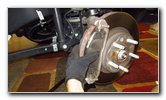 Push Pads Against Rotor |
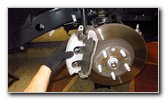 Lower Caliper Over Pads |
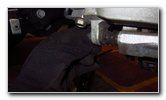 Spin In Caliper Bolts |
| Push the two pads
together until they are flush against the rotor. Carefully lower the caliper over the new pads and into the bracket. Line up the bolt holes. If the caliper won't fit over the new pads, you might need to compress back the pistons a bit more. Spin in the two caliper bolts a few turns in the counterclockwise direction (as seen from the outside of the car) to help prevent them from becoming cross threaded. |
||
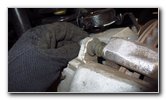 Spin In Top Caliper Bolt |
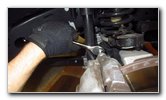 Tighten Counterclockwise |
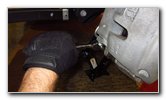 Tighten Lower Bolt |
| Tighten the two
caliper bolts in the counterclockwise direction (as seen from the outside of
the SUV) with the 13mm socket and a 3/8" drive ratchet. If you have a torque wrench, the service manual specification for tightening the 13mm front caliper bolts is 27 lb-ft (or 37 N*m). Double check that the caliper bolts are tight before moving on to the next steps. |
||
 Rubber Valve Cap |
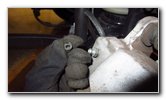 Brake Fluid Bleeder Valve |
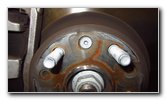 Torx T30 Rotor Set Screw |
|
If your brake pedal has been feeling soft or spongy, the brake fluid may be contaminated with water or the brake lines may contain a few air bubbles. It would be best to bleed the brake lines at this time in order to flush out the old fluid and replace it with either some new DOT 3 brake fluid. (Check your owner's manual.) For more on this topic, check out my Brake Line Fluid Bleeding With An Assistant DIY Guide or alternatively the Brake Line Fluid Bleeding With A Power Bleeder Guide. The brake fluid bleeder valve is located underneath a rubber cap on the back side of the caliper just below the top caliper bolt. To open and close the brake fluid bleeder valve, you'll need an 11mm wrench. |
||
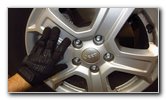 Replace Front Wheel |
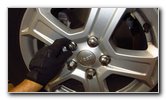 Spin On Five Lug Nuts |
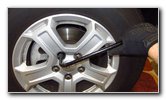 Slightly Tighten Clockwise |
| Carefully replace
the front wheel and tire.
Spin on the five lug nuts a few turns by hand in the clockwise direction to help prevent them from becoming cross threaded. Slightly tighten the lug nuts with the tire iron in the clockwise direction in a star or criss-cross pattern. |
||
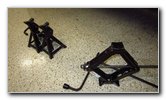 Lower Car From Stands |
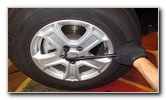 Torque = 130 lb-ft |
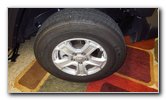 Front Brake Job Done! |
| Carefully lower the
vehicle from the jack stands.
Continue tightening the lug nuts in a star pattern until they are snug. It would be best to use a torque wrench to tighten the lug nuts to the torque specification listed in the owner's manual which is 130 lb-ft (or 176 N*m). The correct 1/2" drive socket size for tightening the lug nuts is 22mm. Please double check your owner's manual for the correct lug nut torque specification. Sit inside the vehicle and pump the brake pedal a few times to restore the brake line pressure. Check the brake fluid level in the reservoir and some new DOT3 brake fluid if necessary. For more,
please check out all of my
2018-2023 Jeep Wrangler DIY Maintenance Guides. |
||
| If you found this guide to be helpful,
please consider making a small donation by clicking on the PayPal.com
"Donate" button located to the right of this paragraph. Thank you!
(Note: I am not a registered charity. Donations are not tax deductible.) |

